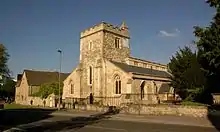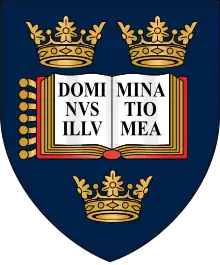Balliol College, Oxford
Balliol College (/ˈbeɪliəl/)[4] is one of the constituent colleges of the University of Oxford in England. One of Oxford's oldest colleges,[5] it was founded around 1263 by John I de Balliol, a rich landowner from Barnard Castle in County Durham, who provided the foundation and endowment for the college.[6] When de Balliol died in 1269 his widow, Dervorguilla, a woman whose wealth far exceeded that of her husband, continued his work in setting up the college, providing a further endowment and writing the statutes. She is considered a co‑founder of the college.[7]
| Balliol College | ||||||||||||||||||
|---|---|---|---|---|---|---|---|---|---|---|---|---|---|---|---|---|---|---|
| Oxford | ||||||||||||||||||
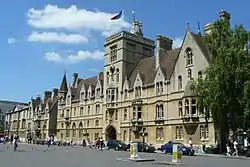 | ||||||||||||||||||
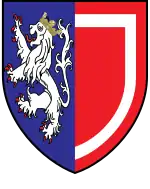 Arms: Azure, a lion rampant argent, crowned or, impaling Gules, an orle argent.[1] | ||||||||||||||||||
| Location | Broad Street | |||||||||||||||||
| Coordinates | 51.7547°N 1.2578°W | |||||||||||||||||
| Full name | Balliol College | |||||||||||||||||
| Latin name | Collegium Balliolensis | |||||||||||||||||
| Established | 1263 | |||||||||||||||||
| Named for | John I de Balliol | |||||||||||||||||
| Sister college | St John's College, Cambridge | |||||||||||||||||
| Master | Dame Helen Ghosh | |||||||||||||||||
| Undergraduates | 366 (2017/2018)[2] | |||||||||||||||||
| Postgraduates | 359[2] | |||||||||||||||||
| Endowment | £119.1 million (2018)[3] | |||||||||||||||||
| Website | www | |||||||||||||||||
| Boat club | Balliol College Boat Club | |||||||||||||||||
| Map | ||||||||||||||||||
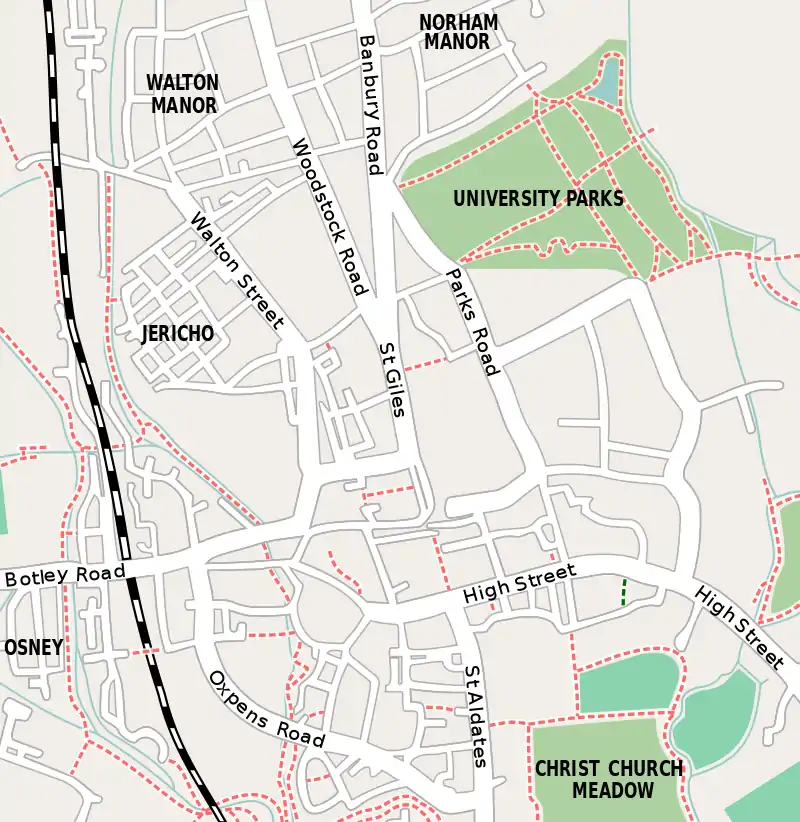 Location in Oxford city centre | ||||||||||||||||||
The college's alumni include the incumbent Prime Minister of the United Kingdom, Boris Johnson, as well as three former prime ministers (H. H. Asquith, Harold Macmillan and Edward Heath), Harald V of Norway,[8] Empress Masako of Japan, five Nobel laureates, and numerous literary and philosophical figures, including Shoghi Effendi, Adam Smith, Gerard Manley Hopkins, and Aldous Huxley. John Wycliffe, who translated the Bible into English, was Master of the college in the 1360s.[7]
History
Foundation and origins
Balliol College was founded in about 1263 by John I de Balliol under the guidance of Walter of Kirkham, the Bishop of Durham. According to legend, the founder had abducted the bishop as part of a land dispute and as a penance he was publicly beaten by the bishop and had to support a group of scholars at Oxford.[9] After de Balliol's death in 1268, his widow, Dervorguilla of Galloway (their son and grandson each became Kings of Scotland), made arrangements to ensure the permanence of the college in that she provided capital and in 1282 formulated the college statutes, documents that survive to this day.
Along with University and Merton, Balliol can claim to be the oldest Oxford college. Balliol's claim is that a house of scholars was established by the founder in Oxford in around 1263, before Merton in 1274 and University in around 1280.[10][11]
New Inn Hall
Under a statute of 1881, New Inn Hall, one of the remaining medieval halls, was merged into Balliol College in 1887.[12] Balliol acquired New Inn Hall's admissions and other records for 1831–1887[13] as well as the library of New Inn Hall, which largely contained 18th-century law books.[12] The New Inn Hall site was later sold and is now part of St Peter's College, Oxford.
The Masque of Balliol
In 1880, seven mischievous Balliol undergraduates published The Masque of B-ll--l, a broadsheet of forty quatrains making light of their superiors – the master and selected fellows, scholars, and commoners – and themselves. The outraged authorities immediately suppressed the collection, and only a few copies survived, three of which found their way into the college library over the years, and one into the Bodleian Library. Verses of this form are now known as Balliol rhymes.
The best known of these rhymes is the one on Benjamin Jowett. This has been widely quoted and reprinted in virtually every book about Jowett and about Balliol ever since.
First come I.
My name is J-W-TT.
There's no knowledge but I know it.
I am Master of this College,
What I don't know isn't knowledge.
This and 18 others are attributed to Henry Charles Beeching. The other quatrains are much less well known.
William Tuckwell included 18 of these quatrains in his Reminiscences in 1900, but they all came out only in 1939, thanks to Walter George Hiscock, an Oxford librarian, who issued them personally then and in a second edition in 1955.[14]
Balliol–Trinity rivalry
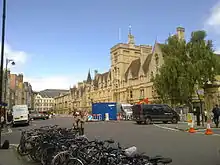
For many years, there has been a traditional and fierce rivalry shown between the students of Balliol and those of its immediate neighbour to the east, Trinity College.[15] It has manifested itself on the sports field and the river; in the form of songs (of varying degrees of offensiveness) sung over the dividing walls; and in the form of "raids" on the other college. The rivalry reflects that which also exists between Trinity College, Cambridge and Balliol's sister college, St John's College, Cambridge.
In college folklore, the rivalry goes back to the late 17th century, when Ralph Bathurst, President of Trinity, was supposedly observed throwing stones at Balliol's windows.[16] In fact, in its modern form, the rivalry appears to date from the late 1890s, when the chant or song known as a "Gordouli" began to be sung from the Balliol side.[17]
The traditional words run:[18]
Gordouli
Face like a ham,
Bobby Johnson says so
And he should know.
The shouting of chants over the wall is still known as "a Gordouli", and the tradition continues as the students gather to sing following boat club dinners and other events. The traditional Gordouli is said to have been sung by Balliol and Trinity men in the trenches of Mesopotamia in the First World War.[19]
Balliol became known for its radicalism and political activism in the 20th century, and saw an abortive coup in the 1960s in which students took over the college and declared it "the People's Republic of Balliol".[20] The contrast between the radical tendencies of many Balliol students and the traditional conservatism and social exclusivity of Trinity gave the rivalry an extra edge. The fact that Balliol (in contrast to Trinity) had admitted a number of Indian and Asiatic students also gave many of the taunts from the Trinity side a distinctly racist tone: Balliol students, for example, were sometime referred to as "Basutos".[21]
In Five Red Herrings (1931), a Lord Peter Wimsey novel by Somerville alumna Dorothy L. Sayers, Lord Peter (a Balliol man) is asked whether he remembers a certain contemporary from Trinity. "'I never knew any Trinity men,' said Wimsey. 'The Jews have no dealings with the Samaritans.'"[22] Sayers also alludes to the rivalry in Murder Must Advertise (1933): Mr Ingleby, a Trinity man, comments, "If there is one thing more repulsive than another it is Balliolity."[23]
One of the wittier raids from Balliol, in 1962 or 1963, involved the turfing of the whole of Trinity JCR (complete with daffodils).[24] The last incident suspected to relate to the feud was the vandalisation of Trinity's SCR pond, which led to the death of all but one of the fish.[25]
Women at Balliol
For over seven hundred years Balliol College admitted men only. New College had in 1964 resolved to admit women, but had been prevented from doing so without the approval of the university, which argued that this would be detrimental to the existing women's colleges. On 2 June 1971 a consilium at Balliol voted 26–2 to admit women, and at the next college meeting on 6 December 1971 it was resolved 30–8 to admit women 'as soon as the change in its Statutes permitting this was approved by the Privy Council'. Permission was granted by the university on 8 March 1977. With the appointment of Carol Clark to a Tutorial Fellowship in Modern Languages in 1973, Balliol became the first ancient all-male college to appoint a female fellow.[26]
Before the full admission of women as undergraduates, the college had decided to establish a co-educational graduate institution. The decision was made on 16 March 1964, and the senior tutor approached St Anne's College shortly after this. The creation of the Balliol–St Anne's Graduate Institution with St Anne's in 1967 led to the coeducation of men and women on the Holywell Manor site. Following the arrival of women at Balliol and men at St Anne's in 1979, the joint Graduate Institution was terminated in 1984 by the consent of both colleges. Holywell Manor is now solely a part of Balliol College.
In 1979, along with many other previously all-male colleges, Balliol accepted its first cohort of female students.[27] The first woman undergraduate to reside at Balliol was Elena Ceva-Valla, who arrived on 16 September 1979. In 2010, the college unveiled a sundial in the Garden Quad commemorating the thirtieth anniversary of the admission of women to the college,[28] inscribed with the phrase "About Time". The first portrait of a woman in Hall since that of the co-Founder, Dervorguilla of Galloway, was unveiled in 2012, depicting benefactor and Oxford Internet Institute founder Dame Stephanie Shirley.[29] This portrait has since been joined by portraits of Carol Clark and the mathematician Dame Frances Kirwan.[30][31]
In 2018 Dame Helen Ghosh succeeded Sir Drummond Bone to become the college's first female master.[32] In the same year Dame Frances Kirwan became the twentieth Savilian Professor of Geometry and the first woman to hold that post.[33]
Between the years of 2015 and 2017, 39.4% of UK undergraduates admitted to Balliol were women.[34]
Buildings and grounds
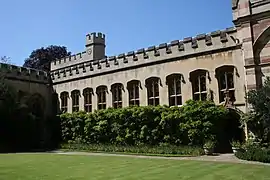
%252C_Oxford.jpg.webp)
The college has been on its present site since its inception by Balliol's scholars as their residence with a lease dating to 1263 to them being the traditional "foundation" date.
Front quadrangle
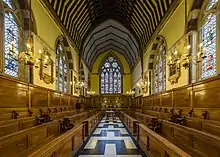
The oldest parts of the college are the north and west ranges of the front quadrangle, dated to 1431, respectively the medieval hall, west side, now the "new library" and the "old library" first floor north side. The ground floor is the Old Senior Common Room. Balliol's second library pre-dates the publication of printed books in Europe. There is a possibility that the original Master's Chamber, south west side, adorned with a fine oriel window, is earlier than these; it is now the Master's Dining Room.
William Grey, Bishop of Ely, was a benefactor of the college in the 15th century. Grey devoted much care to the collection of manuscripts, and wherever he resided constantly employed scribes to make copies of such books as he could not otherwise obtain. Many of these he had adorned with costly miniatures and initial letters by the skill of an artist who worked for him at Florence. It was his desire to make his collection the nucleus of a library for Balliol College, to the building of which, as well as to that of the master's lodgings and of the old buttery and hall, he contributed largely. The work was finished about 1477 by Robert Abdy, then master of the college, and enriched with some two hundred manuscripts, the bishop's gift. Of these, many were destroyed in the reign of Edward VI and during the great rebellion, and by Wood's time few of the miniatures in the remaining volumes had escaped mutilation. But by 1890, no less than 152 of Grey's codices were still in the possession of the college, and form a large part of Roger Mynors's 1963 catalogue of the college's manuscripts.[35] The bishop's coat of arms (gules, a lion rampant, within a bordure engrailed argent) is displayed on two windows of the Old Library, and in the panels below the window of the Master's dining room.
The chapel is the third (perhaps fourth) on the site and was designed by William Butterfield in 1857.
Alfred Waterhouse designed the main Broad Street frontage of the college (1867–68), along with gateway and tower, known as the Brackenbury Buildings after philanthropist and donor Hannah Brackenbury, replacing earlier structures (Staircases I–VII). The first staircase next to the Chapel contains the Organ Scholar's lodgings.
Garden Quadrangle
South-side is the front part of the Master's Lodgings on Broad Street from the Waterhouse improvements of the 1860s of the front quad. The neighbour to this is the Fisher Building of 1759 (Stc X) The undistinguished looking Stc XI, south west side, is in fact the oldest structure in this quadrangle, 1720, originally intended as accommodation for scholars from Bristol, hence its name. Continuing the west-side Stc XII–XIV dates from 1826, by George Basevi, and marks the beginnings of the college's academic renaissance being required for the increasing number of Commoners applying for places. Stc XV by Warren of 1912 filled in the last gap of the quadrangle; the ground floor and basement is the principal Junior Common Room. This unfortunately obscures the lines of the Salvin designed Stc XVI–XIX with Tower of 1853. As does the 1968 building by Beard Stc XX, replacing a Victorian structure. This completely hides a formal gateway similar to that at the Broad Street main entrance, this can be viewed outside from Little Magdalen Street, through the gap marked XIX one finds the small function room "Massey Room". At north side, of Stc XX is the "Back Gate" which is part of the 1906 Warren building, west and north side, Stc XXI. 1 St Giles' is its neighbour which is part of the college and houses the Oxford Internet Institute. Beard's Stc XXII replaces Victorian rooms, which were provided from the Vivian Bulkeley-Johnson benefaction. Beard's Stc XX and XXII are connected by the Snell Bridge accommodation at third-floor level, which was provided from Glasgow University's Snell Benefaction.
The college's dining hall was built in 1877, replacing an older hall in the front quadrangle, which had become too small for the college's population.[36] Designed by Alfred Waterhouse,[37] the hall is built in geometric style, using Bath stone and Tisbury stone, with roof and woodwork made of oak.[36] The hall features a Willis organ, again instituted by Benjamin Jowett.[38] The old hall became part of the library.[39]
The ground floor contains the college bar and shop, known as "The Buttery" (west side) and the Senior Common Room lunch room (east side). The 1966 new Senior Common Room range (Stc XXIII) (northern and eastern sides) was a benefaction of the Bernard Sunley Foundation and contains some smaller rooms and the principal SCR lounge, replacing Victorian facilities. Below this is a Lecture Room ("LR XXIII").
The east side of the quad is a neighbouring wall with Trinity College, at the southern end is the Master's Garden, in front of the chapel, and the Fellows' Garden in front of the "Old" (Senior) Common Room. The Tower forming the corner between the "Old Hall" and "Old Library" is also by Salvin, of 1853 and balances that at Stc XVI–XIX.
Underneath part of the Garden Quad and extending into Trinity were the Balliol-Trinity Laboratories, the most prominent Oxford physical and chemical laboratories in late nineteenth and early twentieth centuries, in which physical chemist Henry Moseley (originator of the atomic number) and Nobel Laureate Cyril Hinshelwood worked. These are now disused, following the construction of the university Physical and Theoretical Chemistry Laboratory on South Parks Road.
The Garden Quad at Balliol is the scene of the well-known limerick that parodies the immaterialist philosophy of Bishop Berkeley:
There was a young man who said, God
Must think it exceedingly odd
If he finds that this tree
Still continues to be
When there's no one about in the Quad.
and also of the response, by the Balliol-educated Catholic theologian and Bible translator Ronald Knox, which more accurately reflects Berkeley's own beliefs:
Dear Sir, your astonishment's odd:
I am always about in the Quad.
And that's why the tree
Will continue to be,
Since observed by, Yours faithfully, GOD.
Holywell Manor, Manor Road and Jowett Walk
The majority of research and post-graduate students are housed in the Holywell Manor complex, a Grade II listed building acquired by Balliol in 1932 under the direction of Kenneth Norman Bell. It hosts a collection of artworks by alumni of the college, including a mural by Gilbert Spencer depicting the college's founding, and hosts a biennial Holywell Manor Festival,[40] Garden Party, and Garden Play. Balliol hosts more graduate students than any other ancient college,[41] and the Manor forms the centre of this community, providing facilities such as the Middle Common Room (MCR) itself, an extensive garden, TV and computer rooms, music practice rooms, a 'Cockpit' leisure room, and the graduate-student-run 'Megaron' bar. The Manor from 1967 until the full admission of women at Balliol in 1979 was host to the Balliol-St Anne's Graduate Institution, including students from St Anne's College, Oxford. Former residents include Bill Clinton and Masako, Empress of Japan.
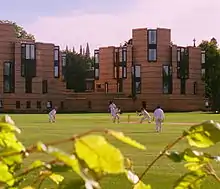
The 20th century saw several further additions to the college's accommodation, the Martin Building of 1966 ('Holywell Minor', a reference to Holywell Manor, across the road) and the Dellal Building (1986) for graduates on Manor Road.
Many undergraduates and some graduates live in buildings on Jowett Walk a phased development 1996–2004 (Phase 1 completed September 1996, Phase 2 completed July 2004),[42] containing a small theatre facility, five minutes' walking distance from the main college site; these two developments are on the outskirts of the Master's Field, the sports ground and pavilion facilities of the college. Jowett Walk has also provided accommodation for some non-Balliol undergraduates, as part of an arrangement with Wadham College, Oxford.
From 2010 St Cross Church, next to the Manor, has been the college's Historic Collections Centre, an extension to the library's services. The church dates from the 11th or 12th century and is a Grade I listed building. This is the third time an Oxford college has incorporated a redundant church as a Library (see Lincoln College and St. Edmund Hall).[43]
In 2017 the college entered into a specialised financial arrangement which enabled it to project a new 200 plus 'study-bedsits' accommodation range at the Master's Field/ Jowett Walk/ St Cross Road site which would also replace the Eastman Professor's House, Martin and Dellal buildings there. This would mean a net increase of approximately 140 rooms fulfilling the college's long-term intention of providing accommodation to all its undergraduates for all their Degree terms and also some rooms for Dons.
The project includes ten new buildings and a new sports pavilion, including a space for dining, events, spectators and squash courts in the basement. The first building opened in spring 2019 and the completion and occupation of the rest is due by January 2021. In the first phase, work began on the south of the site, at the corner of Jowett Walk and St Cross Road, to provide the accommodation for undergraduates and the new pavilion.
Oxford Internet Institute
Balliol College, and its previous Master Andrew Graham, played a major role in 2000–01 in setting up the Oxford Internet Institute. This was the first multidisciplinary research and policy centre in a European university devoted to examining the impact of the Internet on society . It is a department within the Social Sciences Division of Oxford University, but is physically located within the grounds of Balliol, and its previous Director (William H. Dutton) was a Professorial Fellow of Balliol.
Student life
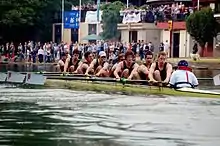
Facilities
The college provides its students with facilities including accommodation, the Hall (refectory), a library, two bars, and separate common rooms for the fellows, the graduates and undergraduates. The JCR provides many services from laundry facilities, one of the few entirely student-run bars left in Oxford (the Manager, Lord/Lady Lindsay, is elected each year by students in the JCR) to a student-run cafeteria known as Pantry. There is a garden quadrangle and a nearby sports ground (the Master's Field) and boathouse. The sports ground is mainly used for cricket, tennis, hockey and football. Croquet may be played in the Master's Field or, in the summer term, in the garden quadrangle.
The majority of undergraduates are housed within the main college or in the modern annexes (Jowett Walk buildings) around the sports ground. The graduates are housed mainly within Holywell Manor which has its own bar, gardens, common room, gym and computing facilities.

Traditions and customs
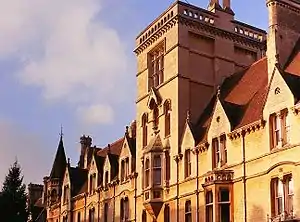
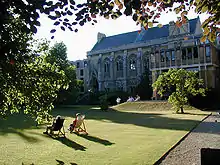
Along with many of the ancient colleges, Balliol has evolved its own traditions and customs over the centuries, many of which occupy a regular calendar slot.
The patron saint of the college is Saint Catherine of Alexandria. On her feast day (25 November), a formal dinner is held for all final year students within Balliol. This festival was well established by 1550. Another important feast is the Snell Dinner. This dinner is held in memory of John Snell, whose benefaction established exhibitions for students from the University of Glasgow to study at Balliol (the first exhibitioners were matriculated in 1699) one of whom was Adam Smith. The feast is attended by fellows of Balliol College, the current Snell Exhibitioners, and representatives from Glasgow University and St John's College, Cambridge.
The MCR has one black-tie dinner each term: the Christmas Dinner in Michaelmas, Burns Night in Hilary, and the May Dinner in Trinity Term.
By far the most eccentric event is The Nepotists carol-singing event organised by the college's Arnold and Brackenbury Society. This event happens on the last Friday of Michaelmas term each year. On this occasion, Balliol students congregate in the college hall to enjoy mulled wine and the singing of carols. The evening historically ended with a rendition of "The Gordouli" (see Balliol–Trinity rivalry below) on Broad Street, outside the gates of Trinity College, although in recent years the song has been sung from within the college walls.
A college society which no longer survives is the Hysteron Proteron Club, which aimed to live one day of each term backwards.[44]
Tortoises
Balliol also takes pride in its college tortoises. The original tortoise, who resided at the college for at least 43 years, was known as Rosa, named after the notable German Marxist Rosa Luxemburg. Each June, pet tortoises from various Oxford colleges are brought to Corpus Christi College where they participate in a very slow race; Balliol's own Rosa competed and won many times. Rosa disappeared in the Spring of 2004, and while numerous conspiracy theories abounded, none is officially recognised by the college. However, on 29 April 2007, Chris Skidmore, a graduate of Christ Church working at the House of Commons, donated a pair of tortoises - one to his own college, and one to Balliol, where he had attended an open day in 1999. The new tortoise, Matilda, died in April 2009. Taking care of the resident tortoise is one of the many tasks assigned to Balliol students each year. This position, known as "Comrade Tortoise", has been filled by a student every year.
People associated with Balliol
Notable people
Balliol has produced a wide range of graduates in the fields of economics, history, law, physiology, medicine, management, humanities, mathematics, science, technology, media, philosophy, poetry, politics, and religion who have contributed significantly to public life. Balliol people were, for example, prominent in establishing the International Baccalaureate, the National Trust, the Workers Educational Association, the welfare state, the Campaign for Nuclear Disarmament and Amnesty International.[45]
Balliol has produced numerous Nobel Laureates. Five Nobel Laureates were students at Balliol: Cyril Norman Hinshelwood (Chemistry, 1956), John Hicks (Economics, 1972), Baruch S. Blumberg (Physiology or Medicine, 1976), Anthony J. Leggett (Physics, 2003) and Oliver Smithies (Physiology or Medicine, 2007). Seven more have been fellows of the college: George Beadle (Physiology or Medicine, 1958), Norman Ramsey (Physics, 1989), Robert Solow (Economics, 1987), John Van Vleck (Physics, 1977), Gunnar Myrdal (Economics, 1974), Linus Pauling (both Peace, 1962, and Chemistry, 1954), and William D. Phillips (Physics, 1997).
Balliol played an important role in early modern science. The early Newtonian David Gregory became Savilian Professor of Astronomy and a fellow of Balliol in 1692; the mathematician James Stirling, best remembered for Stirling's approximation for factorials, was an undergraduate at Balliol, a Snell and Warner exhibitioner expelled in 1715 for his correspondence with Jacobites; and the astronomer James Bradley, best known for discovering the aberration of light and therefore conclusively demonstrating that the speed of light is finite, was a student at Balliol (1711–1714), and was appointed Savilian Professor of Astronomy in 1721 and became the third Astronomer Royal in 1742.[46]
Evolutionary biologist Richard Dawkins was a student there from 1959 to 1962.
Andrew Copson, Chief Executive of Humanists UK and President of the International Humanist and Ethical Union graduated in 2004.
In politics, Balliol has produced four British Prime Ministers: H. H. Asquith, Harold Macmillan, Edward Heath and Boris Johnson as well as politicians with senior leadership positions in the three major political parties, including Jo Grimond, Denis Healey and Roy Jenkins. Labour Party MP, former cabinet minister and 2015 Labour leadership candidate Yvette Cooper and Conservative Party MP and government minister Rory Stewart are current politically prominent alumni. Richard von Weizsäcker, President of Germany from 1984 to 1994, also studied at Balliol. Royal alumni include Empress Masako of Japan and Olav V of Norway, after whose donation of expanding the JCR is named the Norway Room, his son and current king Harald V of Norway also studied here.
In journalism, the New Statesman’s political editor Stephen Bush, the Guardian’s chief arts writer Charlotte Higgins, and columnist and Labour communications specialist Seumas Milne are alumni of the college.
In the law, Thomas Bingham was the Senior Law Lord of the United Kingdom, while Brian Hutton and Alan Rodger held equivalent positions in Northern Ireland and Scotland, at one point, all three simultaneously. Cressida Dick is the current Commissioner of the London Metropolitan Police, the first woman to hold this role.
Literary figures include John Minford, Robert Southey, David Aaronovitch, Christopher Hitchens, Matthew Arnold, Gerard Manley Hopkins, Arthur Hugh Clough, Hilaire Belloc, Ronald Knox, Graham Greene, Joseph Macleod, G. F. Bradby, Anthony Powell, Aldous Huxley, Christopher Hollis, Robertson Davies, Nevil Shute, Algernon Charles Swinburne, and Gwyneth Lewis.
Notable Balliol philosophers include Adam Smith (Snell Exhibitioner), T. H. Green, J. L. Austin, Charles Taylor, Bernard Williams, R. M. Hare, Michael Sandel, Joseph Raz, Peter Geach, Michael Otsuka, Derek Parfit, Michael E. Rosen, and Timothy Williamson.
Balliol has also contributed to the sporting world; I. A. K. Pataudi and his son Tiger Pataudi, both India cricket captains and the 8th and 9th Nawabs of Pataudi respectively, were both Balliol graduates who played for the University. US Olympian rower Caryn Davies received her MBA at Balliol.
Balliol members have predominated as holders of the office of Chancellor of the University from the 20th century to the present; George Nathaniel Curzon, Harold Macmillan, Roy Jenkins and Chris Patten, the last two being opposed in their election by Edward Heath and Lord Bingham of Cornhill respectively. Members of the college have been elected to masterships not only at Balliol but also at other colleges, and include the current Master of Christ's College, Cambridge, Jane Stapleton, a former fellow of Balliol.
Howard Marks, a convicted drug dealer and later author, attended Balliol between 1964 and 1967 to study physics and then again between 1968 and 1969 to study History and Philosophy of Science.
The first person documented to brew coffee in England, Nathaniel Canopius, was a Cretan student at Balliol from 1637 to 1648.[47]

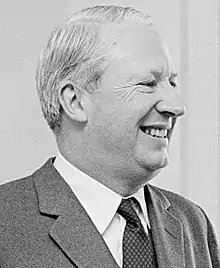
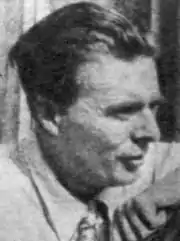 Aldous Huxley, writer and philosopher
Aldous Huxley, writer and philosopher.jpg.webp)
.jpg.webp)
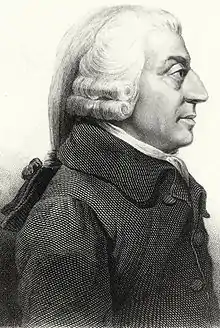 Adam Smith, economist and author
Adam Smith, economist and author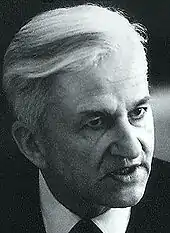
Academics and Fellows
As with all colleges, Balliol has a more or less permanent set of teaching staff, known as Fellows. The college statutes provide for various categories of Fellows and these include both tutorial fellows and professorial fellows. Professorial fellows are those professors and readers of the university who are allocated to the college by the university. One of these professorships is the Beit Professor of Commonwealth History, which is currently held by James Belich. The Professorship of Internet Studies is currently held by political scientist Philip N. Howard. Other professorships include the Boden Professor of Sanskrit and the Montague Burton Professor of International Relations. Official Fellows are those who hold tutorial or administrative appointments in the college. There are also senior and junior research fellows. The college can also elect "distinguished persons" to honorary fellowships.
The fellows are supplemented by academics on short-term contracts. In addition, there are visiting international academics who come to Oxford for periods of up to a year, an example of this is the George Eastman Visiting Professorial Fellowship.[48]
Masters
%252C_Oxford.jpg.webp)
Balliol College is run by the master and fellows of the college. The master of the college must be "the person who is, in their [the Fellows] judgement, most fit for the government of the College as a place of religion, learning, and education".[49] The current master is Dame Helen Ghosh, former Director-General of the National Trust and Home Office Permanent Secretary, and an alumna of St Hugh's and Hertford colleges.
Although the rules in no way suggest there is a preference for an alumnus or Fellow of the college to be chosen there have been few who were not, only one in the 20th century had no previous connection. A former student of the college, Baruch Blumberg was the first American master and the first Nobel Laureate, receiving his prize in medicine for the identification of the hepatitis B virus. The outgoing Master of Balliol Sir Drummond Bone was a post-graduate student there (Snell Exhibitioner from Glasgow University) and a scholar of the Romantic poet Lord Byron, and held the post from October 2011 to April 2018 following his retirement as Vice-Chancellor of the University of Liverpool in 2008.[50]
References
- "Balliol Archives - College Arms". Ox.ac.uk.
- "Student statistics". University of Oxford. 2017. Retrieved 31 August 2018.
- "Balliol College : Annual Report and Financial Statements for the year ended 31 July 2018" (PDF). Ox.ac.uk. p. 22. Retrieved 5 March 2019.
- "Colleges - University of Oxford". Ox.ac.uk. Retrieved 1 June 2019.
- Sir Charles Edward Mallet (1968). A History of the University of Oxford: The mediaeval university and the colleges founded in the Middle Ages. Barnes & Noble. p. 83.
- Alexander Chalmers (1812). The General Biographical Dictionary Containing an Historical and Critical Account of the Lives and Writings of the Most Eminent Persons. 3 (new ed.). J. Nichols. pp. 384–385.
- "A brief history of Balliol College". Balliol College. Retrieved 27 October 2018.
- "Harald 5". Snl.no. 17 April 2018. Retrieved 1 June 2019.,
- Jones, John (10 July 1997). Balliol College: A History, Second Edition: Reissue, with revisions. Oxford University Press. ISBN 9780199201815. Retrieved 16 February 2019.
- "Q & A : oldest established". Balliolarchivist.wordpress.com. Retrieved 8 March 2019.
- Brockliss, L. W. B. (2016). The University of Oxford: A History. Oxford: Oxford University Press. pp. 64–66. ISBN 9780199243563.
- "Library History". Balliol College, Oxford.
- "Balliol Archives - tracing a Balliol man". Balliol College, Oxford.
- "The Balliol rhymes" by Walter George Hiscock
- Hopkins, Clare; Ward-Perkins, Bryan (1989–1990). "The Trinity/Balliol Feud". Trinity College Oxford Report: 45–66.
- Hopkins and Ward-Perkins, "Trinity/Balliol Feud", p. 45.
- For the Gordouli, see Knight, G. Norman (1969). "The Quest for Gordouli". Balliol College Record.; reprinted in Trinity College Oxford Report, 1984–85.
- "Gordoulis" was a popular brand of Egyptian cigarette. As "Gordouli", it became a nickname applied by Balliol men to a Trinity undergraduate, Arthur Galletti. Bobby Johnson, later Deputy Master and Controller of the Royal Mint, was an undergraduate at New College. See Knight, "Quest for Gordouli".
- Knight, "Quest for Gordouli".
- Baraniuk, Chris, ed. (December 2010). The Oxford University Alternative Prospectus. p. 34.
- Hopkins and Ward-Perkins, "Trinity/Balliol Feud", pp. 54–60.
- Sayers, Dorothy L. (1968) [1931]. Five Red Herrings. London: New English Library. p. 157. Wimsey's Biblical quotation is from John 4: 9.
- Sayers, Dorothy L. (1969) [1933]. Murder Must Advertise. London: New English Library. p. 8.
- Hopkins and Ward-Perkins, "Trinity/Balliol Feud", p. 51.
- Segrove, Natalya. "Trinity fish murdered". Cherwell.org.
- "Obituary for Carol Clark - Balliol College, University of Oxford". Balliol.ox.ac.uk.
- "Balliol Women: Some Alumnae of the College | Balliol College, University of Oxford". Balliol.ox.ac.uk. Retrieved 4 May 2018.
- "Women at Balliol sundial unveiled - Balliol College, University of Oxford". Balliol.ox.ac.uk.
- "Portrait unveiled in Hall - Balliol College, University of Oxford". Balliol.ox.ac.uk.
- "Unveiling of portrait of Professor Frances Kirwan in Hall". Balliol College News. Retrieved 28 June 2019.
- Leech, Emma. "Oxford University announces new diverse portraits". Cherwell. Retrieved 23 August 2019.
- Weale, Sally (18 July 2017). "Dame Helen Ghosh to leave National Trust for Balliol College, Oxford". the Guardian.
- "Frances Kirwan elected 20th Savilian Professor - Balliol College, University of Oxford". Balliol.ox.ac.uk.
- "Annual Admissions Statistical Report 2018" (PDF). Ox.ac.uk.
- Mynors, RAB (1963). Catalogue of the Manuscripts of Balliol College Oxford. Oxford: Clarendon. p. 401.
- The Architect: A Weekly Illustrated Journal of Art, Civil Engineering and Building. 18. Gilbert Wood & Company, Limited. 1877. p. 247.
- "Drawings of Balliol by Augustus Welby Northmore Pugin (1812-1852)". Balliol College. Retrieved 27 October 2018.
- "Jowett Papers - Biographical Index". Balliol College. Retrieved 27 October 2018.
- "Library History". Balliol College. Retrieved 27 October 2018.
- "Holywell Manor Festival 2018 - Balliol College, University of Oxford". Balliol.ox.ac.uk.
- "Students by college/permanent private hall". Ox.ac.uk. Retrieved on 10 August 2018.
- "Jowett Walk project description". MJP Architects. Archived from the original on 27 August 2009.
- Historic England. "Church of St Cross (1369450)". National Heritage List for England. Retrieved 9 July 2015.
- John Hely-Hutchinson, Carol Symphony: the life and times of Victor Hely-Hutchinson, pp. 39-40
- Near-complete lists of Fellows and students can be found in the published Balliol College Register; the 1st edition (1914, covering matriculations 1832–1914), 2nd edition (1934, covering matriculations 1833–1933) and 3rd edition (1953, covering matriculations 1900–1950).
- Jones 2005, pp. 148–149.
- Horan, David (1999). Oxford: A Cultural and Literary Companion. Signal Books. p. 67. ISBN 978-1-902669-05-2. Retrieved 17 March 2020.
- "Balliol Website (Archived)". Archived from the original on 6 December 2004. Retrieved 5 November 2004.
- Statute II "The Master", clause 1
- "Election of New Master". News Page. Balliol College, Oxford. 18 March 2011. Retrieved 25 June 2011.
Further reading
- Jones, John (2005). Balliol College: a history (2nd, revised ed.). Oxford: Oxford University Press. ISBN 9780199201815.
External links
| Wikimedia Commons has media related to Balliol College, Oxford. |
